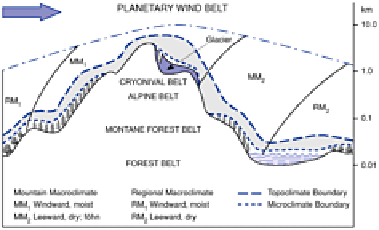Environmental Engineering Reference
In-Depth Information
Figure 25.9
The scale and variety of mountain climates.
Mountain topoclimate (shaded) separates myriad surface
microclimates from the broader mountain macroclimate. The
logarithmic scale refers to the thickness of each layer, not to
the absolute altitude.
Source: Modified from Barry (1992).
through condensation levels, either in the waves or in isolated
rotors
, and - in stable air -
evaporates on the descending limb, leaving stratiform lee wave or rotor clouds (Plate
25.4).
Fall winds
describe air currents descending leeward slopes, distinguishable by their
thermal character and development according to diurnal, seasonal or synoptic conditions.
Warm-air downflow is generated under particular lapse rate conditions which lead to
warming on descent known as the
föhn
(Alps) or
chinook
(Canadian Rockies) effect.
This occurs when stable air loses moisture over the barrier and descends at a dry
adiabatic lapse rate with an absolute gain in temperature (Figure 25.10). Most currents
adiabatically warm on descent but are less powerful mechanically and thermally. The
föhn or chinook occurs seasonally in most mountain systems; the native Canadian term
means 'snow-eater', underlining their important environmental influences as warm,
desiccating winds.
Contrasting
cold
-
air drainage
occurs as gravity flows of denser air, such as the
bora
(Adriatic Sea) or
oroshi
(Japan). In their simplest form they are currents of cold air
ponded up on windward slopes and draining through passes or other topographic lows.
Cold air is also

